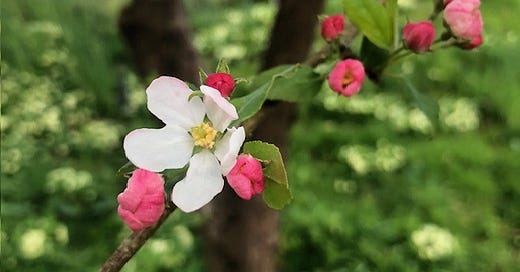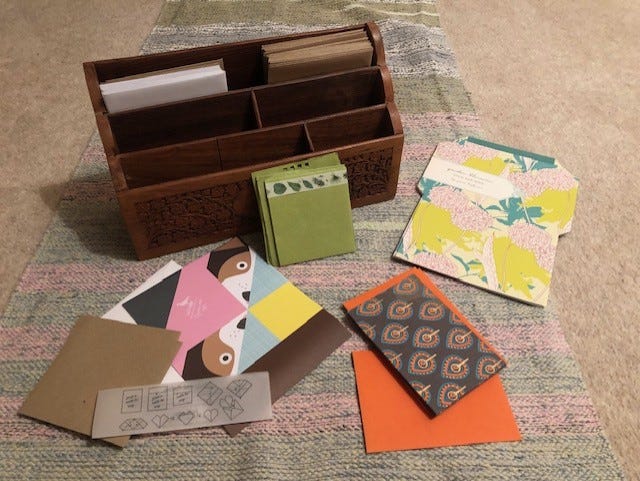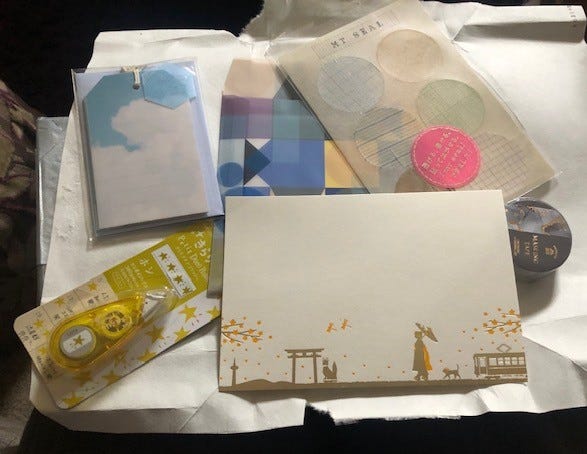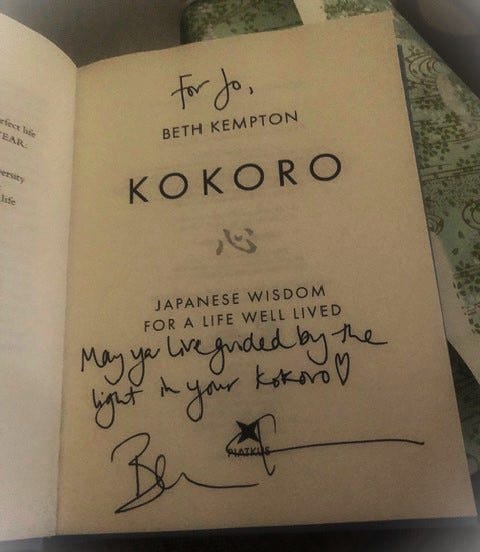We are in the holiday where some people are marking the story of Easter. The Easter story is the resurrection- an ultimate ending, and new beginning. In line with these themes, it is the perfect time to create new beginnings at home. We often do this with a good old spring clean, and today was an especially good day to do this as the warm and sunny spring was washed away by the rain!
Beautiful spring blossom, blooming on a strange day of hail, rain and sunshine!
A couple of years ago I tried the Marie Kondo approach to decluttering. Kondo’s method is heart-led but systematic. She advises working through different categories of item in the house, putting them all in one place, then going through them. Every item is looked at in turn, and you ask yourself if you still want it in your life. The important thing is whether it sparks joy. If not, out it goes, with an appreciative thank you for whatever it brought to your life.
It’s surprising how much stuff accumulates over the years, and asking every item to see if it sparks joy is time consuming. But, if you can be ruthless and persist long enough to get through even a few of the categories, it can be effective way to prune your stuff. The category that I found hardest to complete was the books. There are many TBR (To Be Read), but when some have been resident for 10 plus years and remain unopened, it is time to accept they may never be, and put them in the box for the charity shop. In truth, they are unlikely to be missed.
Once lightened of possessions, Kondo advises mindful consideration of everything new that comes into your home. This way the clutter won’t return. I’m clearly out of practice and it’s time to consider another clear out.
The stuff of stuff
Many of the things we own are functional, or time saving, or increase our comfort. Sometimes things are held onto just in case they are needed, or are kept as we intend to re-purpose, upcycle, or rehome them, especially where the likely consequence is that they’ll end up in landfill. The simplest thing would be to throw them away, but when something leaves our home, it does not simply disappear. We may feel a responsibility to the planet, bringing up feelings of guilt, especially if we think the item might still be useful. It is easy to identify the things that bring joy, but items rooted in guilt can be more challenging to confront and perhaps harder to get rid of.
Are the tendencies towards clutter or minimalism individual personality traits, or family patterns, or related to our personal experiences, I wonder? In a discussion I had this week, one woman told me that her tidiness fluctuates with her menstrual cycle, which is something I had not considered before. There are likely many contributing factors at play.
I like to have a tidy home, but do not always live in one. I watched a TV programme with Brian Cox a few years ago, and it reassured me that my failure to keep my house tidy is due to entropy. It’s physics, not a personal failing.
Note- Obviously Professor Cox made no direct reference to me, nor tidying up a house in general as the programme was about space, but my extrapolations are surely valid!
Another term for the force working against my intentions, is the family tendency towards what I call wombling. This was inherited from my father’s side. My granddad was an engineer, gardener, and all round fixer upper. He had many sheds and workshops, a long garage, and a house all full of useful stuff.
‘You never know when it will come in handy’
It is as if this unspoken motto slunk down my paternal line. My maternal grandmother is a different breed. She is not one for holding onto things she does not need, although her cabinet of inherited tea sets and cut glass have not seen a drop of drink for many years. What stories might this collection have to tell, and what will be lost if these items do not continue to pass down the family line, I wonder, mindful that none of her grandchildren have the space for this inheritance.
Wombling
Let’s explore the idea of wombling. Wombles are long nosed, furry, fictional creatures who lived on Wimbledon common. They were early environmentalists, finding creative uses for things that they found. If you want a blast from the past (or indeed to see what on earth I’m talking about if you’ve not heard of them before), follow this link for a video of the Wombles performing the theme song, or this one for an episode where they find treasure. I forgot how charming they are!
‘Making good use of the things that we find, things that the everyday folks leave behind.’
The inevitable side effect of the ‘just in case’ or wombling way, is that we tend to accumulate more and more stuff. How many old cardboard boxes or padded envelopes do we need for ‘just-in-case’ situations? Maybe there could be a matching service where minimalists buddy up with wombling hoarders. When the minimalist needs to send a parcel, or needs a particular type of screw, there is no need for a shop, their wombling buddy will surely have a range of options from which to choose. What a brilliantly green and healthy mutualism! Alternatively, we need to value and cultivate these two aspects of ourselves, drawing on the Kondo part of our self, when the wombling gets out of hand.
A cluttered house, a cluttered mind?
Does your living space become a reflection of the state of your mind? Research suggests that clutter is associated with creativity, but there is presumably a tipping point where clutter becomes problematic. I suspect we each have different tipping points, but once met, it can negatively impact on relationships and well-being. See Kristen Fuller’s August 2023 article with a round up of some of the research about this.
Conscious of this, I started spring cleaning my study today. I removed everything from the top of my desk to dust, rubbing at the ink stains with spray polish to try to get them off. One of the simplest and most satisfying tasks is filing paperwork. There’s no point in having a quiet room of one’s own if the noise of correspondence spills all over the writing spaces. I had quite a pile to get through, despite there supposedly being less of it now with electronic letters and bills.
On the opposite side of the room to my desk is a bookcase. It was coated in a thin film of dust. Dust has a magical quality of appearing invisible, then drawing attention to itself when an item on the shelf is moved slightly. The clean and shiny patch shouts out until it is all dusted clean, unless you can wait long enough for another layer of dust to fall and cover it up. Spring cleaning vanishes these.
Dusty treasures
Dusting invites us to look closely. I imagine it is not often that we stop and look at all the things on our bookshelves, but dusting offers an opportunity to consider whether we want to keep things there. Do we want them taking up our space?
The bookcase in my workspace contains a mix of poetry collections, books about psychology, spirituality and creative writing, and my doctoral thesis. I rarely look at some of these, yet could discard none. If only I got round to reading them all! I suspect I am not the only one on Substack with this book problem… It made me wonder, what is the average ratio of read : to be read books on a household study shelf? What is the ratio on yours? I think it would make an interesting Substack survey! Would any of us actually be honest?!
I managed to nudge myself out of reflection and back into action. My stuff came straight off the shelves, and after dusting, went straight back on. I only considered one item at any length. A wooden letter rack that I have had for almost 30 years.
So does this spark joy?
I’m not sure…
It not an obvious source of joy. It is missing a wooden insert that separates the sections, and contains mostly envelopes and writing paper. It isn’t as practical as it might seem, as it takes up more space than if I just put the stationery in a drawer but it has pretty carvings of flowers on the front, and I’ve had it for a long time, making it hard to let go. It has character. It has beauty. But I feel ambivalence that I can’t fully explain. Am I attached to what it contains, and the joy that the stationery sparks, rather than the letter rack itself sparking joy? I have had it for almost 30 years, so something clearly keeps it in my possession.
Letter writing
It is lovely to have beautiful stationery and I wonder if having it on display rather than tucked in a drawer reminds me to look and enjoy it. I have always loved writing letters, and at one time, writing paper or notelets were often received as a birthday gift or at Christmas. There aren’t many people to whom I write letters now, yet a pretty envelope landing on my doormat, and the anticipation of what lies inside is sure to put a smile on my face.
The person to whom I wrote the most letters was my great aunt. I credit her as the gardener of my writing practice through the encouragement of my letter writing at university, although I didn’t realise it at the time.
There was no mobile communication when I went to university, and our connections were formed and maintained in real conversation, either in person or via the landline telephone, and by letter (That makes me feel old!). Letter writing, and sending cards was more common that it was now, and there was a big alphabetised pigeon hole by the JCR (Junior Common Room). Every couple of weeks I would write to my aunt, telling her what I was doing. Every so often she would send a brief reply, often enclosing money, or a book of stamps. It was in my undergraduate degree that I learned about classical and operant conditional and that intermittent reinforcement is the strongest way to maintain a behaviour! I’ll never know whether it was intentional, but it certainly worked. Looking back, it was a generous way for my aunt to make me feel my letters were appreciated, and encouraged me to keep writing even as my academic and professional life closed in on science.
I have one of the letters that I wrote to my aunt as a young child. I notice that I have made the blank note paper my own, drawing a picture. The woman appears to have a cat, a flower, a place for her craft materials, and a plant that is growing. All things that spark joy! And for those of you who know the poem Warning, by Jenny Joseph, it brings me a lot of joy that she’s wearing a purple dress!
Stationery sparking joy
How often do we get letters written on beautiful stationery, or ordinary scraps of paper adorned with the pictures children have drawn especially for us? My answer is, very rarely. I fear that stationery and writing by hand are dying arts. What does it feel like to pick up a piece of paper that is soft to touch, or embossed in gold, or has a picture that lights up our heart and brings joy? What do we feel when we see the personality of our friend scrawled across the page. How many people’s handwriting do we recognise these days? How much more joy do these things bring than the electronic mail in the generic type of Times New Roman or Calibri?
What is it like to pick up a piece of our favourite writing paper? What does it smell like? How do we choose the pen with which we write? I bet we are more careful with what we put on the page, and how we do it. Every page is precious. Indeed, one of my friends who shares a love of stationery tells me that some of hers is too precious to use! I hear you, but my hope is that in using it, and sending it in the post, the joy is sparked in others.
I wonder as I write this, if our approach to beautiful writing paper reveals something about how we approach life. Every day is like taking up a precious page of notepaper, something we cannot do over. Each day we write ourselves onto the page.
Do we think about every word, where we place it, and how it might be received? Do we write it out in rough first? Do we freeze and write nothing? Or censor what we say? Or panic, and write the first thing that comes into our head, leaving a sense of regret or disappointment? Do we write to be liked? Or do we surrender to the flow of the pen, and enjoy the beauty of each and every sheet of notepaper, writing from our hearts, gladly sharing our beautiful selves with others? Let us write joyfully and with as much beauty as we can!
A fine balance
We cannot know what each day will bring, and there are always unexpected endings and beginnings. On Monday I shared the following post in my notes-
Monday afternoon, and a knock at the door. The postman has a parcel for me.
I turn it over, not recognising the handwriting, curious who it might be from.
Inside a card, and two shapes wrapped in beautiful paper…
First I open the card…
Aha!! The gift I won from the draw by @Beth Kempton when seeking views on her blurb.
Thank you Beth. I can’t wait to open them! Well, clearly I can, I came to post a thank you first 😂
This was a gift I knew was coming, but did not expect when it arrived! Inside the parcel was a beautiful collection of Japanese stationery, and Beth’s latest book, Kororo. These certainly sparked joy. I‘m now considering who I will send the embossed notelet to, or whether to keep it on the noticeboard above my desk. I have not yet read beyond the foreword of Beth’s book, but I have been sitting with the invitation she wrote in the front.
May we all live guided by the light in our kokoro.
Kokoro, intelligent heart, feeling mind.
How do we do this? I’ve not read Beth’s advice on this yet, but I can tell you mine begins with a spring clean. Doing so allows us to balance the Womble wisdom and the Marie Kondo way, and consider the question, does this spark joy? If not, we have the option of giving thanks, and discarding it from our life, to follow our own path of light. And those tricky things that linger due to guilt, those need to go too.
It isn’t always easy, but we really can choose.
There may be aspects of our life that we want to womble, and repurpose and repair, but we do not have to collect the rubbish of the world. The Wombles are discerning. They do not bring all the rubbish into their homes, only the things they know they can make use of.
Our personal pains and sorrows will be amongst our inner and outer clutter, and we can let them be, or like with my ink stain on the desk, we can work on them and over time they will become more faint.
If there are things we are not ready to let go of, and the ‘just in case’ pull is strong, these impulses are rooted in feelings of safety. We can leave tricky aspects until we are ready, but clearing out what we can, helps to prevent the feeling of overwhelm.
We cannot make ourselves new, or perfect, but we can talk to ourselves kindly, recognising we have likely done the best that we can today, and tomorrow we might make different choices. By saying thank you, and letting go of what no longer serves us, we are free to keep finding the joy in the here and now.
Returning to the cleaning, I am going to tackle the next room in my house. I do not want the beautiful things in my home to go unnoticed amongst the clutter. We need to keep considering what we let into our lives, and getting the right balance for us. If it feels tricky, perhaps create an image of Marie Kondo and a few of the Wombles standing alongside you, and sing the theme tune! Bringing fun and joy to the task will lighten the load.
I’d love you to share in the comments the things that spark your joy, especially if it’s a picture of your own beautiful stationery collection!
What helps you to find your right balance? What joyful aspects of your life might you resurrect? I might send a letter.
Go well x








Some similar themes here over the last few days - tidying and dusting for the first time in a very long time and reflecting on why I have decided to use my precious and limited energy on this now. I realised it is very much aligned with letting go of some grief and looking ahead. I decided to start a new notebook tomorrow for Easter even though the my old one isn't full - not for creative writing but for some notes on Buddhist teachings and practices - there is a sense of needing to start afresh now my circumstances have changed. And it's so nice to have a slightly tidier, less dusty flat!
Aw thanks for that blast from the past from childhood! I'd forgotten all about the Wombles 😂 I have Beth's book on order too, can't wait to read it 🩷